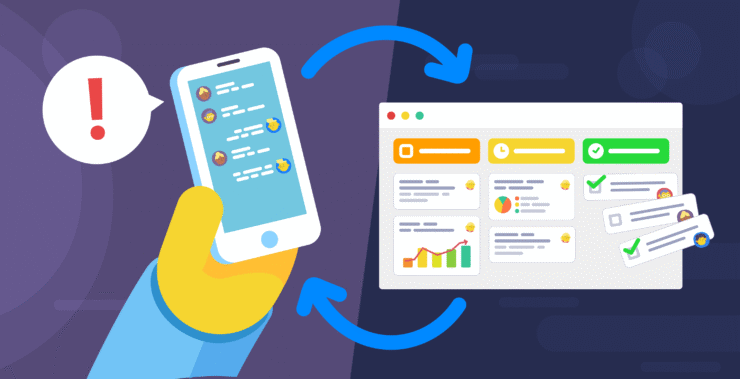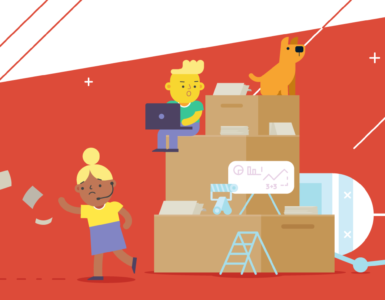Let’s face it: communicating with customers can be challenging sailing. Certain days, you’re firing off emails like a pro and feeling like you’ve got it all under control; other days, it’s like your inbox, chat notifications, and social media DMs have joined forces to test your patience.
The truth is, that customer communications can be overwhelming. But with the right set of customer communication management tools, you make it manageable – and even, dare we say, enjoyable. No longer juggling between platforms and trying to keep up with all messages, you will have just about everything you need at your fingertips to keep customers happy and workflow running with ease.
In this article, we’ll look at tools that can help you manage everything from email to live chats to social media messages. Not only will these tools save you a lot of time, but they will also keep your customers happy, engaged, and coming back for more. If you’ve ever wanted an easier way to stay connected, you’ve come to the right place.
Why Customer Communication Tools Are Vital
Communication with customers is rather like trying to hold a conversation at a noisy party. You’ve got messages coming from all directions-email, live chat, social media – and unless you’re organized, things can quickly get out of hand. The right customer communication tools can help you turn that chaos into smooth, efficient communication.
Here’s why these tools are a must-have for your business:
Centralized Communication Saves Time
Managing messages across different platforms can be time-consuming. One minute, you’re responding to emails, the next, you’re checking DMs or chats, and it’s easy to lose track of important details.
Customer communication tools pull everything in one place for better organization. Whether it’s an email, live chat, or social media message, you can log in and respond to all queries from one dashboard. Such centralization saves time and doesn’t let you miss any of the messages.
Fast Replies Increase Customer Satisfaction
Today, the customers are living in a fast-moving world and expect quick responses. A difference of a few hours may mean the difference between keeping a customer and losing them.
Customer communication tools allow you to automate responses, prioritize urgent messages, and even set up workflows to ensure the right team member handles each request promptly. The result? Faster response times and happier customers.
Consistency Across All Channels
Customers want consistency in their experience, no matter how they contact us. Whether it’s through email, social media, or live chat, they want to feel like they’re speaking to the same company with the same quality of service.
It’s too easy to drop the thread, especially when customers are contacting you across multiple platforms. These tools ensure that the messaging on different platforms syncs to give a seamless experience each time.
Team Collaboration Enhances Efficiency
When communication is spread across a bunch of different apps or channels, team members can’t have all the information they need to provide effective support. It leads to delays, confusion, and mistakes.
Customer communication tools, like a shared Gmail inbox, help your team work efficiently by providing shared access to customer interactions.. Since everything is in one place, team members can collaborate in real-time, ensuring issues are handled quickly and accurately.
Personalization Creates Better Experiences
Customer communication tools are more than just mechanisms for handling requests. They are the bridge to lasting, meaningful connections. As you keep track of past conversations, preferences, and unique information about each of them, every interaction turns into an opportunity to make a customer feel recognized, valued, and appreciated. Rather than feeling like just another faceless inquiry in some queue, they feel like a priority.
These will help you create a tapestry of personalized communication where every interaction flows from the previous one. With organized systems that have all information at their fingertips, your team will be able to answer them quickly and thoughtfully. You create seamless experiences combining efficiency with genuine care that nurture loyalty and trust. Customers don’t just come back; they come back because they feel recognized, not as some number, but as an individual.
Eventually, the right customer communication tools enhance not only the quality of the service but also the relationships one gets to build, making every interaction well beyond business – just proof of the care and attention you give to those who matter most.
Best customer communication tools for 2025
1. Beamer
Beamer is a communication tool designed to help companies inform their customers about important updates, announcements, and news in the most interactive and accessible way. It’s perfect for SaaS companies or businesses that want to keep their customers informed about new features, changes, or oBeamer is a communications tool that helps companies to create a deeper engagement with their customers. It’s perfect for SaaS companies or any business that needs to keep customers updated on new features, changes, or special offers. With Beamer, updates become more than just announcements – they’re a way of keeping your customers in the loop and earning trust.
With its customizable news feed, Beamer creates a space where updates don’t get lost in the noise. Customers have the ability to opt in for notifications so they never miss important developments. It integrates with your website or app to display your updates in an in-app feed and sends targeted messages based on customer actions. Beamer also doubles as a customer service feedback platform, allowing users to interact with updates through comments and reactions – providing valuable insights into customer sentiment.
This targeted approach increases the likelihood that customers will engage with the content that matters most to them. While real-time updates allow you to keep customers in the loop without bombarding them with unnecessary information.
Key features:
- Customizable News Feed: You can create a dedicated space where customers can view updates, product improvements, and announcements.
- In-App Announcements: Beamer allows you to deliver in-app notifications to users based on their behavior.
- Segmentation: Target specific customer groups based on actions or interests for more relevant communication.
- Analytics: Track which updates are most engaging and fine-tune your messaging strategy accordingly.
Beamer helps you stay connected with your customers, making sure they’re always informed, but never overwhelmed. It’s about sharing just the right information at the right time.
2. SurveyMonkey
SurveyMonkey is a tool that lets businesses listen to their customers directly by providing a bridge to meaningful feedback. It’s not just about gathering data but really understanding the subtlety of each response and turning that knowledge into action. Whether you want to measure customer satisfaction, gauge opinions, or test interest in new concepts, SurveyMonkey provides an intuitive platform for uncovering the insights that lead to smarter decisions.
Designing a survey with SurveyMonkey, featuring a drag-and-drop builder and professional templates, is almost instinctive. Share your surveys widely on email, social media, or embed them on your site. Analyze responses in real time as they start coming in for clear views about customer sentiments.
What really makes SurveyMonkey powerful, though, is segmenting and digging deeper into your data. You can break down responses by demographics, behavior, or even trends that let you refine products, adjust services, and communicate with more precision. This makes it not just a tool but a guide toward better business decisions, always changing the voices of your customers.
Key features:
- Survey Creation: Easily create surveys with a drag-and-drop builder and customizable templates.
- Real-Time Analytics: View responses as they come in, offering a real-time snapshot of customer sentiment.
- Segmentation: Target different customer segments for tailored surveys, improving the relevance of feedback.
- Reporting: Detailed reports and data analysis to better understand your customer base.
By directly engaging with your customers, SurveyMonkey doesn’t just give you feedback; it fuels a dialogue that evolves and refines your business to speak directly to their needs.e customer experience.
3. Zendesk
Zendesk is a customer service platform designed to bring all your support channels – email, live chat, and social media – into one seamless space. Instead of juggling scattered conversations, teams can manage customer inquiries from a single dashboard, ensuring no request slips through the cracks.
Every customer interaction, whether it starts with an email, a tweet, or a chat message, is turned into a trackable ticket. From there, it’s routed to the right person, keeping responses organized and efficient. Automated workflows help speed up resolutions, from sending quick replies to common questions to making sure follow-ups aren’t forgotten.
Apart from request management, Zendesk provides a better view of support operations for businesses. Reporting tools in the software highlight trends, measure response times, and point out areas for improvement. With everything in one place, support teams can focus on what matters most-helping customers quickly and effectively.
Key features:
- Multi-Channel Support: Manage support requests from email, live chat, phone, and social media in one place.
- Automation and Workflows: Automate responses to common queries, reducing response time and increasing efficiency.
- Help Center and Knowledge Base: Provide customers with self-service resources for common issues.
- Reporting and Analytics: Track performance metrics, identify bottlenecks, and improve response times.
Zendesk helps you provide a seamless and responsive customer experience by consolidating all support channels, reducing response time, and enabling more efficient team collaboration.
4. HubSpot
HubSpot is a powerful CRM platform that unifies a company’s approach to growing customer relationships by combining marketing, sales, and customer service tools in one place. Its primary goal is to make communicating with leads, prospects, and customers easy, automated, and connected across multiple touchpoints. It is an ideal tool for companies in their initiative to align the marketing and sales departments while maintaining a personal high touch.
HubSpot offers a suite of integrated tools that cover every stage of the customer journey. From lead capture forms and email marketing automation to live chat features and post-sale customer service, HubSpot keeps all customer communication in one system. The platform also features a robust CRM where businesses can track customer interactions and set up automated workflows.
They allow the creation of workflows comprising follow-up emails, task assignments, and lead nurturing sequences. Its robust analytics tools give details of customer behavior to enterprises so that future communications can be personalized and marketing campaigns fine-tuned accordingly.
Key features:
- CRM Integration: Track customer interactions and store important details for personalized communication.
- Email Marketing: Create automated email workflows to stay connected with customers.
- Live Chat and Chatbots: Interact with customers instantly through live chat or automated bots.
- Analytics and Reporting: Gain insights into customer behavior and optimize communication strategies.
HubSpot helps businesses maintain strong relationships by centralizing all customer data and communication, allowing for personalized and automated interactions that improve customer satisfaction.
5. Salesforce
Salesforce is that huge toolbox that a business needs when managing all of its customer relationships: efficiently and flawlessly. It is a web-based collaboration platform in which it stores the customer interactions – the customer email, phone call, or social media post – all in one place and makes everything work error-free. By providing end-to-end customer communication tracking, Salesforce allows you to track every customer touchpoint, giving your team full visibility into past interactions so you never miss a key detail.
From Salesforce pipeline manager to accurate sales forecasting, automation of day-to-day tasks in marketing – Salesforce gets the work out of the way with automation of customer communication so that you never miss anything. Such repetitive processes like reminders and follow-ups are effectively run through automated processes with workflows so that no customer communication slips through the cracks. Salesforce makes it easier and smoother to reach out to customers and equips with tools that automate customer communications but also give tips on how to do better engagement.
Its client communication tool capabilities extend beyond simple call and email monitoring. The platform integrates all the channels, giving you a holistic picture of customer behavior, preferences, and interactions. Having this 360-degree view, you are able to customize your communication and make every customer heard and valued.
Key features:
- Sales Cloud: Track sales opportunities, manage leads, and automate workflows.
- Service Cloud: Deliver personalized customer service through chat, email, and phone.
- Marketing Cloud: Automate marketing campaigns and personalized communications.
- Reports and Dashboards: Create custom reports to track engagement and performance metrics.
Salesforce centralizes all customer data, providing a 360-degree view of your customer interactions, enabling personalized communication and improving overall customer service and engagement.
6. FuseBase
FuseBase is an all-in-one customer engagement platform where making communication contextually relevant in real-time becomes effortless. It instantly connects businesses with their customers through live chat and automated messaging. With its customer communication automation capabilities, FuseBase ensures that your team can respond promptly while the system handles routine interactions like FAQs, freeing up time for more complex queries.
This client communication tool takes it a step further by offering proactive messaging, sending personalized updates or offers based on customer behavior. With customer communication tracking integrated into your CRM, every interaction is logged and easily accessible, ensuring smooth transitions and meaningful, timely engagement. The integration provides the context your team needs to offer personalized responses, and it ensures consistency across all touchpoints, from initial inquiry to follow-up.
FuseBase’s ability to combine live chat, bot automation, and proactive messaging enables businesses to build deeper, more personalized relationships with customers, driving satisfaction and loyalty. By automating routine tasks and tracking all customer interactions, FuseBase helps you maintain a high level of customer interaction and engagement, turning every conversation into an opportunity to connect on a deeper level.
Key features:
- Live Chat: Connect with customers in real time to answer questions and resolve issues.
- Bot Automation: Use AI-powered bots to handle simple queries and direct customers to the right department.
- Proactive Messaging: Trigger personalized messages based on customer behavior.
- Integration with CRM: Sync with your CRM for a seamless flow of customer data.
FuseBase helps you maintain a high level of customer interaction by offering real-time support, automating routine tasks, and personalizing customer experiences, leading to better engagement and satisfaction.
Final thoughts
Customer communication tools are no longer a luxury but a necessity in the way of improving customer relationships. From streamlining feedback collection using client communication tools to real-time support powered by live chat, the right set of tools can help you meet and greet your customers where they are and keep them engaged.
This ranges from Beamer to SurveyMonkey to Zendesk to HubSpot to Salesforce, the new FuseBase, and several other players, each with varied features to help you manage your customer communications more efficiently.
The key takeaway?
Investing in the right tool is about making communication with your customers seamless and personalized. Whether you need to deliver important updates, collect valuable feedback, or provide instant support, there’s a solution tailored to your business needs.
First, step back and consider your business goals, your customers, and the touchpoints with them. What are you trying to enhance: quicker response times, more feedback, or perhaps a unified communication platform? Once you begin to paint a clear picture of your needs, your decision regarding the right client communication platform will be much more strategic and impactful.
By integrating the right customer communication tools into your business, you stand to gain better customer satisfaction, deeper engagement, and stronger loyalty.
So, what are you waiting for? Go ahead and start exploring these tools today to take the first step in changing how you communicate with your customers.








